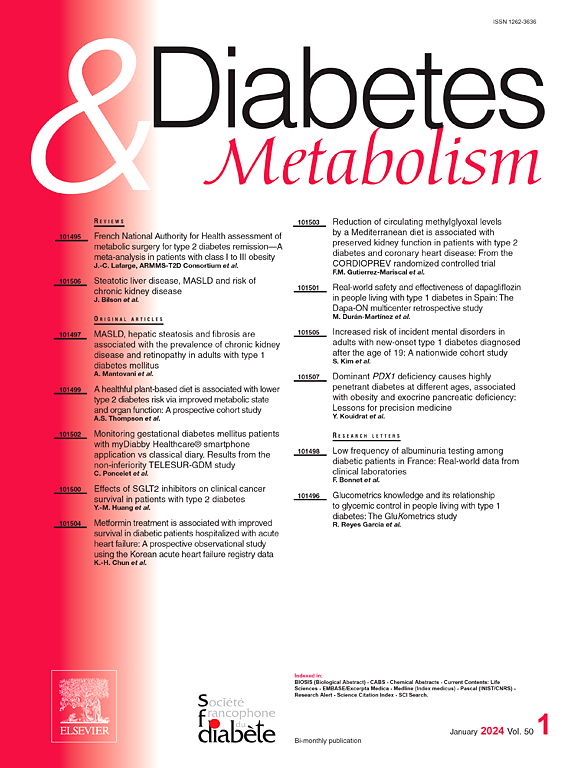1990 - 2021年非老年人2型糖尿病全球负担及2050年预测:2021年全球疾病负担的系统分析
IF 4.7
2区 医学
Q1 ENDOCRINOLOGY & METABOLISM
引用次数: 0
摘要
背景:2型糖尿病(T2D)正日益成为一个主要的全球健康挑战。然而,对非老年人群T2D的研究仍然不足。方法:我们分析了2021年全球疾病负担(GBD)研究的数据,重点关注204个国家和地区15至59岁人群的糖尿病相关指标。这包括患病率、发病率、死亡率和残疾调整生命年(DALYs),根据社会人口指数(SDI)分为21个GBD地区。我们采用联结点回归和贝叶斯年龄-时期-队列模型来评估1990年至2021年的趋势,并预测2021年至2050年的趋势。结果:全球年龄标准化发病率从1990年的196.3 / 10万(95% UI, 145.2-257.4)上升到2021年的361.1 / 10万(95% UI, 275.2-458.4)。患病率、死亡率和伤残调整生命年也呈现出类似的上升趋势。尽管男性和女性的患病率、发病率、死亡率和伤残调整生命年都有所上升,但在几乎所有年龄组中,男性仍然在这些指标上处于领先地位。SDI中低水平国家的疾病负担最为严重。高体重指数是这一人群的主要危险因素。据估计,到2050年,全世界约有11.95亿非老年人将患有T2D,流行病学变化是这种疾病负担的主要驱动因素。结论:这项关于T2D负担的研究表明,其在非老年人中的患病率正在稳步上升,预计到2050年全球将有超过10亿人受到影响。有针对性的措施对于应对这一人群面临的全球健康挑战至关重要。本文章由计算机程序翻译,如有差异,请以英文原文为准。
Global Burden of type 2 diabetes in non-elderly individuals 1990 to 2021 and projections for 2050: a systematic analysis of the 2021 Global Burden of Disease
Background
Type 2 diabetes (T2D) is increasingly becoming a major global health challenge. However, research on T2D in non-elderly populations remains insufficient.
Methods
We analyzed data from the Global Burden of Disease (GBD) study in 2021, focusing on diabetes-related indicators among individuals aged 15 to 59 across 204 countries and regions. This included prevalence, incidence, mortality, and Disability-Adjusted Life Years (DALYs), categorized into 21 GBD regions according to the Sociodemographic Index (SDI). We employed join-point regression and Bayesian Age-Period-Cohort models to assess trends from 1990 to 2021 and forecast from 2021 to 2050.
Results
The global age-standardized incidence rate increased from 196.3 per 100,000 (95 % UI, 145.2–257.4) in 1990 to 361.1 per 100,000 (95 % UI, 275.2–458.4) in 2021. The prevalence, mortality rate, and DALYs exhibit a similar upward trend. Although both men and women have experienced rises in prevalence, incidence, mortality rate, and DALYs, men continue to lead these metrics across nearly all age groups. Low-middle SDI countries bear the most severe disease burden. A high body mass index is a major risk factor in this population. It is estimated that by 2050, approximately 1.195 billion non-elderly individuals worldwide will have T2D, with epidemiological changes being the primary driver of this disease burden.
Conclusions
This study on the burden of T2D reveals that its prevalence among non-elderly individuals is steadily increasing and is projected to affect over a billion people worldwide by 2050. Targeted measures are crucial to tackle this global health challenge for this population.
求助全文
通过发布文献求助,成功后即可免费获取论文全文。
去求助
来源期刊

Diabetes & metabolism
医学-内分泌学与代谢
CiteScore
12.00
自引率
4.20%
发文量
86
审稿时长
13 days
期刊介绍:
A high quality scientific journal with an international readership
Official publication of the SFD, Diabetes & Metabolism, publishes high-quality papers by leading teams, forming a close link between hospital and research units. Diabetes & Metabolism is published in English language and is indexed in all major databases with its impact factor constantly progressing.
Diabetes & Metabolism contains original articles, short reports and comprehensive reviews.
 求助内容:
求助内容: 应助结果提醒方式:
应助结果提醒方式:


